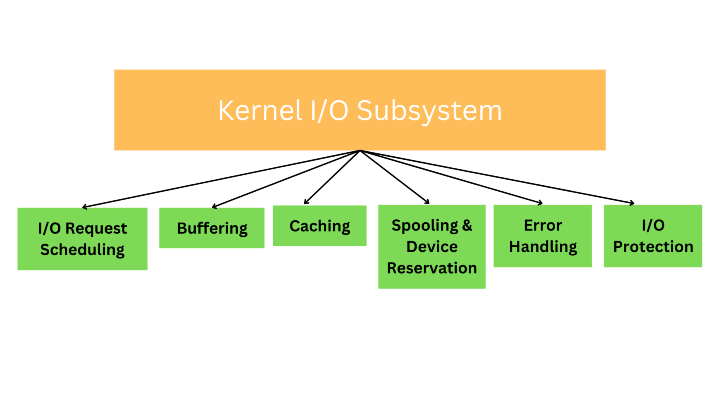
 Data Structure
Data Structure Networking
Networking RDBMS
RDBMS Operating System
Operating System Java
Java MS Excel
MS Excel iOS
iOS HTML
HTML CSS
CSS Android
Android Python
Python C Programming
C Programming C++
C++ C#
C# MongoDB
MongoDB MySQL
MySQL Javascript
Javascript PHP
PHP
- Selected Reading
- UPSC IAS Exams Notes
- Developer's Best Practices
- Questions and Answers
- Effective Resume Writing
- HR Interview Questions
- Computer Glossary
- Who is Who
Kernel I/O Subsystem in Operating System
The Kernel I/O Subsystem is a fundamental component of modern operating systems. It is responsible for managing all input/output (I/O) operations on a computer. The I/O subsystem provides various services that enable efficient and secure management of the I/O operations.

I/O Request Scheduling in the Kernel
One of the key services provided by the I/O subsystem is the scheduling of I/O requests. Scheduling involves determining the best order in which to execute I/O requests to improve system performance, share device access permissions fairly, and reduce the average waiting time, response time, and turnaround time for I/O operations to complete. The OS developers implement schedules by maintaining a wait queue of requests for each device, and the I/O scheduler rearranges the order to improve the efficiency of the system.
Buffering
Another important service provided by the I/O subsystem is buffering. Buffers are used to cope with speed mismatches, provide adaptation for different data transfer sizes, and support copy semantics for the application I/O. A buffer is a memory area that stores data being transferred between two devices or between a device and an application.
Caching
Caching is another service provided by the I/O subsystem. It is a region of fast memory that holds a copy of data, making access to the cached copy much easier than the original file. The main difference between a buffer and a cache is that a buffer may hold only the existing copy of a data item, while a cache holds a copy of faster storage of an item that resides elsewhere.
Spooling and Device Reservation
Spooling and device reservation are also important services provided by the I/O subsystem. They are used to hold the output of a device, such as a printer that cannot accept interleaved data streams, in a buffer known as a spool. All applications' output is spooled in a separate disk file, preventing all output from continuing to the printer. When an application finishes printing, the spooling system queues the corresponding spool file for output to the printer.
Error Handling
Error handling is another crucial function of the I/O subsystem, which guards against many kinds of hardware and application errors. An OS that uses protected memory can prevent a complete system failure from minor mechanical glitches. Devices and I/O transfers can fail transiently or permanently, but the OS can handle such failures in different ways.
I/O Protection
Finally, I/O protection ensures that user processes cannot issue illegal I/O instructions to disrupt the normal function of a system. The I/O subsystem implements various mechanisms to prevent such disruptions by defining all I/O instructions as privileged instructions. Users cannot issue I/O instructions directly, preventing illegal I/O access.
Conclusion
The Kernel I/O Subsystem in Operating System plays an important role in managing I/O operations efficiently and securely. In this article, we discovered that It provides various services such as scheduling, buffering, caching, spooling, device reservation, error handling, and I/O protection. This ensures optimal use of resources and safeguarding the system against errant processes and malicious users. Further, the I/O subsystem is one of the core components of the OS. Its efficient functioning is vital for the smooth operation of the system.

